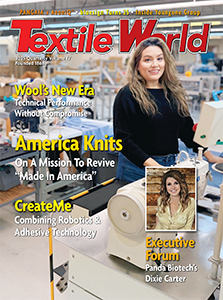
While the textile industry has been going through tough times recently, cycles of good and
bad times are not unique to the industry. Over the long run, every industry has its ups and downs.
So, when tough times hit, why do some firms weather the storm and come out stronger, while others
are casualties At least part of the answer to this critical question has become more evident over
the last two decades. The “secret” to success in good and bad times, across a wide range of
industries, lies in large measure in having a strong corporate culture that ensures the flow of
ever-higher-quality products and services.Defining Corporate CultureWhat is corporate culture Many
different definitions of corporate culture have been offered over the years. At the heart of all
these definitions, however, are two important ideas. First, corporate culture speaks to “how” the
firm has decided to do business. Second, corporate culture, expressed through the core values of a
firm, helps to explain “why” the business should exist, not just from the owners’ perspective, but
for everyone who has a stake in the well-being of the firm.How does corporate culture impact the
quality of products and services produced by a firm and, therefore, its capacity to survive There
are three key ways that culture impacts this relationship. First, as noted above, firms vary in
“how” they like to do business, and these choices make a significant difference in the quality of a
firm’s products and services from year to year. The first widely recognized evidence about this
relationship came out in the early 1980s, when Thomas Peters and Robert H. Waterman published their
bestseller book, In Search of Excellence. In looking closely at many consistently profitable,
high-growth firms across several industries, they discovered that all these companies had a
remarkably similar way of doing business that enhanced their reputation as quality providers.
Specifically, they all shared, in large measure, eight common ways of conducting business: a bias
for taking action rather than overanalyzing issues; a drive to get close to customers; the
willingness to grant employees sufficient autonomy to explore new entrepreneurial opportunities; a
quest to improve productivity by investing in their people; hands-on, value-driven styles of
management; a preference for sticking to businesses they knew how to run; creation of simple
structures and operating with a lean staff; and the granting of operational autonomy at the shop
floor while retaining control over the values of the firm at large.

Core Values Impact Quality And LongevityThe second way corporate culture impacts quality and
longevity was only discovered during the past decade. This connection has to do with understanding
“why” an organization should exist at all. More precisely, in a landmark study that compared the
small handful of high-quality companies that had existed for over 100 years – like DuPont –
compared to the millions that go out of business during the first 20 to 30 years of life, the only
consistent differentiating factor was the nature of the core values that were held as being of
primary importance to the firm. Specifically, when a company is aimed primarily at maximizing
short-term economic gains, it is a high-risk candidate for failure because there is always the
temptation to sacrifice long-term quality for near-term profits. In contrast, when a firm places
primary importance on “changing with the times,” so that a community can be created of individuals
who know who they are and why they hold in common certain values – such as continuously improving
the quality of their products and services – the prospects for long-term survival increase
exponentially
(See “Chas. W. HouseandSons – Striving For Quality,” below).The third way corporate
culture impacts quality and the likelihood of long-term survival stems from the value an
organization places on building systems that both reflect the organization’s core values and are
designed to help ensure the firm will last for the long haul. All of the long-lived organizations
that have been studied to date have placed great importance on this kind of investment in quality
improvement. In contrast, when organizations are “built to flip,” as occurred with many of the
dot.com firms created during the past decade, the end result is less pleasant. What systems need to
be built for a firm to continually enhance the quality of its products and services Research over
the past decade indicates that while many systems can be created, there are four that clearly stand
out as most useful in impacting a firm’s ability to survive and thrive. These systems focus on:
building a deep strategic planning process; creating an intense customer focus that permeates the
organization; enhancing the capacity of a firm to develop its people; and expanding the
organization’s commitment to recognize and reward the efforts of all employees.ConclusionsIn
summary, if you want to make it through these challenging times and thrive over the long term, look
to your corporate culture. Knowing how to improve the quality of your products and services is not
enough. Everyone in your organization must believe and act on this value. So, review and improve
“how” you are doing business. Reflect on and make it clear to employees, customers, shareholders,
and the community “why” you should be in business. Then, enhance or build the systems that will
take your firm to the next level.Chas W. HouseandSons – Striving for QualityChas. W. HouseandSons
Inc., located in the quaint New England village of Unionville, Conn., provides a good example of
how a strong culture can help a firm win in good times and bad. Founded in 1867, over the last
several decades, the company has emerged as a leader in the U.S. market for high-quality woolen and
wool-blend woven felt applications.What is the secret of the firm’s success According to Matt
Bristow, CEO, its longevity is the result of adherence to a basic cultural value that “We are
survivors,” who will change with the times, combined with a prudent set of business practices aimed
at always striving to produce higher quality products and services for their customers. More
precisely, according to Bristow, who bought the firm in 1995 after a distinguished career at The
Stanley Works, its success stems from a culture that is “a blend of long-standing values combined
with the reality of today’s globally competitive marketplace.” In addition, the firm’s ability to
remain in the fight today and do battle tomorrow depends on several key business practices that
reflect its culture: strategic planning, customer focus, as well as developing and recognizing its
employees.HouseandSons’ strategy is based on two key fundamental principals. First, focus on
maintaining and enhancing the firm’s core manufacturing competencies. Second, always be in a
position to make choices around what actions can preserve or strengthen the firm’s leadership
position in its markets. So, for example, when the casino gaming and billiard markets began
changing dramatically over the past five years due to a surge of imports and man-made fibers, the
firm responded by introducing a blend of imported products that could meet or exceed the high
quality standards of home-grown products. This decision was based on the recognition that the firm
could add value to the imported product by performing finishing operations that meet or exceed
market specifications. At the same time, being open to importing allowed the company to explore
opportunities to expand its total product offering by selling other products it did not make.
Another key to the company’s long-standing success has been the concerted drive to establish and
maintain close contact with its customers. For example, the company has actively combined the
efforts of its textile technical and sales engineers to work in unison with its customers’
engineering and product-design staff as a way to identify opportunities to become problem solvers
as well as to improve long-term relationships.

By adhering to basic cultural values, Chas W. HouseandSons Inc. has emerged as a leader in
the U.S. market for high-quality woolen and wool blend woven felt applications.The third key
component of HouseandSons’ business culture is to proactively seek ways to develop and recognize
its employees to the greatest extent possible. To this end, the company provides competitive
industry salaries and a profit-sharing plan, and routinely holds employee-recognition and
communication meetings. Beyond these basics, however, the company has also moved to promote a
culture of greater engagement and accountability by flattening the organization. This has occurred
through the elimination of the position of plant superintendent and similar changes in the sales
and marketing and administrative support areas. At the same time, recognizing employee
contributions has remained a top priority. For instance, in 1996, the company made a key hire of a
textile engineer that allowed it to develop an international sourcing capability. This employee has
since become head of the firm’s textile engineering function. Thus, as new challenges arise, the
company’s leadership, first-line supervisors, and employees can more effectively implement new
business plans through faster product development and a commitment to become ever more
customer-focused.
Editors note: James W. Fairfield-Sonn operates his own consulting practice and is also a
tenured associate professor of management at the University of Hartford, Conn. Fairfield-Sonn
teaches courses in process management and leadership and was voted outstanding teacher of the year
in 1999.His first book, Corporate Culture and the Quality Organization, published by Quorum Books,
focuses on identifying the core activities that are essential to the success of any quality
enhancement effort and how to make them happen in a company or organization.
December 2001




